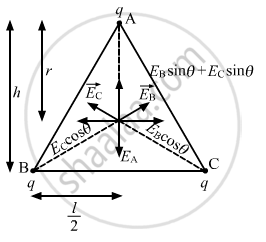Advertisements
Advertisements
Question
Three identical charges, each with a value of 1.0 × 10−8 C, are placed at the corners of an equilateral triangle of side 20 cm. Find the electric field and potential at the centre of the triangle.
Solution
Given:
Magnitude of charges, q = 1.0 × 10−8 C
Side of the triangle,
l = 20 cm = 0.2 m

Let \[E_A , E_B \text{ and } E_C\] be the electric fields at the centre due to the charges at A, B and C, respectively.
The distance of the centre is the same from all the charges. So,
\[E_{net} = E_A - \left( E_B \sin\theta + E_A \sin\theta \right)\]
\[ = E\left( 1 - \sin30^\circ- \sin30^\circ \right)\]
\[ \Rightarrow E_{net} = 0\]
Now,
\[h^2 = l^2 - \left( \frac{l}{2} \right)^2 \]
\[ h^2 = \left( 0 . 2 \right)^2 - \left( 0 . 1 \right)^2 \]
\[ \Rightarrow h = \frac{\sqrt{3}}{10}\]
Let the distance of the centre from each charge be r.
For an equilateral triangle,
\[r = \frac{2}{3}h\]
\[ \Rightarrow r = \frac{2}{3} \times \frac{1 . 732}{10} = 1 . 15 \times {10}^{- 1} \] m
Potential at the centre,
\[V = V_A + V_B + V_C \]
\[ \because V_A = V_B = V_{C,} \]
\[ V = 3 V_A\]
\[V = 3 \times \frac{1}{4\pi \epsilon_0}\frac{q}{r}\]
\[V = \frac{3 \times 9 \times {10}^9 \times {10}^{- 8}}{0 . 115}\]
APPEARS IN
RELATED QUESTIONS
- Two insulated charged copper spheres A and B have their centers separated by a distance of 50 cm. What is the mutual force of electrostatic repulsion if the charge on each is 6.5 × 10−7 C? The radii of A and B are negligible compared to the distance of separation.
- What is the force of repulsion if each sphere is charged double the above amount, and the distance between them is halved?
Three-point charges q, – 4q and 2q are placed at the vertices of an equilateral triangle ABC of side 'l' as shown in the figure. Obtain the expression for the magnitude of the resultant electric force acting on the charge q

(b) Find out the amount of the work done to separate the charges at infinite distance.
Does the force on a charge due to another charge depend on the charges present nearby?
At what separation should two equal charges, 1.0 C each, be placed, so that the force between them equals the weight of a 50 kg person?
Two charges 2.0 × 10−6 C and 1.0 × 10−6 C are placed at a separation of 10 cm. Where should a third charge be placed, such that it experiences no net force due to these charges?
Estimate the number of electrons in 100 g of water. How much is the total negative charge on these electrons?
Suppose all the electrons of 100 g water are lumped together to form a negatively-charged particle and all the nuclei are lumped together to form a positively-charged particle. If these two particles are placed 10.0 cm away from each other, find the force of attraction between them. Compare it with your weight.
Solve numerical example.
Three equal charges of 10×10-8 C respectively, each located at the corners of a right triangle whose sides are 15 cm, 20 cm, and 25cm respectively. Find the force exerted on the charge located at the 90° angle.
Write a short note on superposition principle.
Two-point charges of + 0.2 µµC and -0.2 µµC are separated by 1 o8 m. What is the value of the electric field at an axial point at a distance of 0.1 m from their mid-point?
The electric force acting between two point charges kept at a certain distance in vacuum is 16 N. If the same two charges are kept at the same distance in a medium of dielectric constant 8, the electric force acting between them is ____________ N.
The ratio of the forces between two small spheres with constant charge (a) in air (b) in a medium of dielectric constant K is ______.
The unit of charge is ______.
Identify the wrong statement in the following.
Coulomb's law correctly describes the electric force that ______
According to Coulomb's law, which is the correct relation for the following figure?

Four charges equal to - Q are placed at the four a corners of a square and charge q is at its centre. If the system is in equilibrium, the value of q is ______.
What is meant by the statement: "Relative permittivity of water is 81"?
